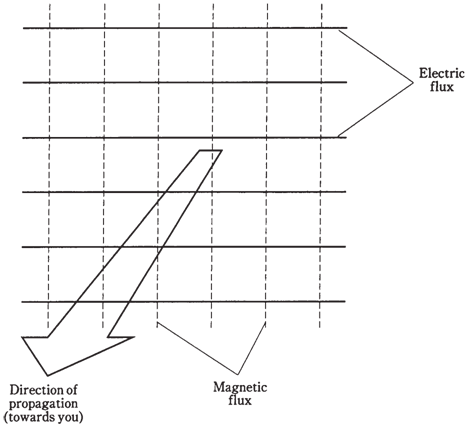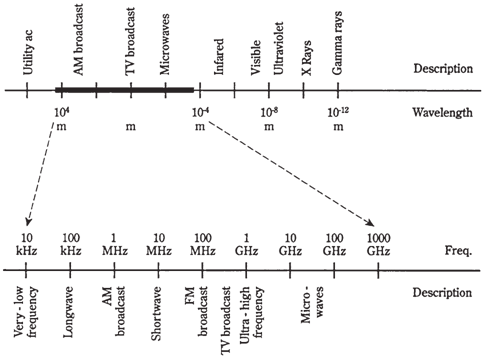The electromagnetic field
In the radio or television transmitting antenna, electrons move back and forth at an extreme speed. The velocity of them is constantly changing as they speed up in one direction, reverse direction, slow down, speed up again, and so on. Any change of velocity is acceleration.When the electrons move, a magnetic field is created. When electrons accelerate, a changing magnetic field is produced. An alternating magnetic (M) field gives rise to an alternating electric (E) field, and this generates another changing M field. The process has come full circle. Therefore it repeats, the effects propagating through space at speed of light. The E and M fields expand outward alternately from source in spherical wavefronts. At any given point in space, E flux is perpendicular to M flux. The direction of wave travel is perpendicular to E and M both flux lines.
The EM flux field can oscillate at any conceivable frequency, ranging from years per cycle to quadrillions of cycles per second. The sun has a magnetic field which oscillates with a 22 year cycle. Radio waves oscillate at the thousands, millions, or billions of cycles per second. Infrared, visible light, X rays and ultraviolet oscillate at many trillions of cycles per second.

Figure--An electromagnetic field consists of electric and magnetic flux lines at right angles.
have exactly same form. The difference is in their frequency. The frequency of an electromagnetic wave is related directly to the wavelength in space.
Frequency versus wavelength
All the electromagnetic fields have frequencies and wavelengths which are inversely related. If fMHz is frequency of a wave in megahertz, and Lft is wavelength in feet, then
Lft = 984/fMHz
for waves in outer space or in the atmosphere of the earth. If wavelength is given as Lm in meters, then
Lm = 300/fMHz
The inverses of these formulas, for finding frequency if the wavelength is known, are
fMHZ = 984/Lft
and
fMHz = 300/Lm
The electromagnetic spectrum
The whole range of electromagnetic frequencies or wavelengths is called as electromagnetic spectrum. In theory there is no limit to how low or high the frequency can be, correspondingly, to how long or short wavelength can be. The common electromagnetic wavelengths range from around 106 m, or 1000 km, to around 10 12 m, or trillionth of a meter.
Scientists use a logarithmic scale to depict the electromagnetic spectrum. A simplified rendition is shown in the figure given below, labeled for wavelength in meters. To find frequencies in megahertz, divide 300 by the wavelength shown. For frequencies in hertz, use 300,000,000 rather than of 300. For kilohertz, use 300,000; for gigahertz, use 0.300.

Figure-- The electromagnetic spectrum, with radio portion expanded.
Radio waves fall into a subset of the spectrum, at frequencies between approximately 9 kHz and 1000 GHz. This corresponds to the wavelengths of 33 km and 0.3 mm. The radio spectrum, that includes television and microwaves, is blown up in the given figure, and is labeled for frequency. To find wavelengths, use conversion formulas. Just be sure you have decimal point in right place with respect to the 3.